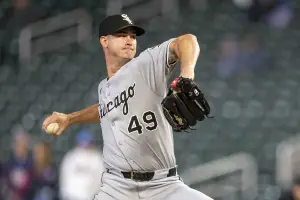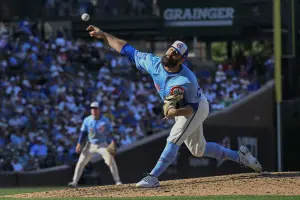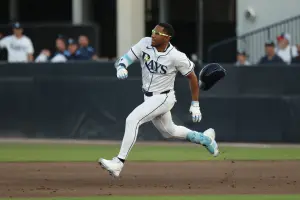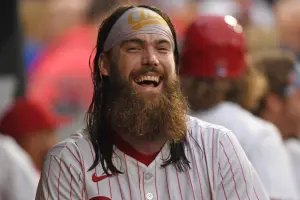
(*) PT TOMORROW: NL East—Buenos Diaz
Heading into the 2019 season, few positions on the Marlins seemed as secure as second base, where Starlin Castro (2B, MIA) has hung his shingle in Miami since coming over from the Yankees before the 2018 season. A disappointing start may have some—specifically, us—wondering if the veteran can keep prospect Isan Díaz (2B, MIA) at bay. Are things as bad as they seem with Castro and what could we expect from Diaz if he got the call?
BHQ’s Greg Pyron recently wrote up Castro in his FACTS/FLUKES column. The Marlins’ second baseman has had a tough time keeping his head above water this season: .227/.269/.283 with 13 R, 3 HR, 13 RBI, 1 SB in 198 AB. That line reads more guppy than marlin, but Pyron pointed out Castro’s low h%, and his career-best 86% ct% and 123 HctX as reasons for hope. He is hitting the ball on the ground a lot (57% GB%), though, which won’t do his power numbers any favors.
Unlock all of our insights on your way to a fantasy title! See what our season-long coverage offers and then subscribe to BaseballHQ.com.
So how likely is Castro to lose his starting job? In spite of the historical unpopularity of most things Castro in Miami, the rebuilding Marlins aren’t terribly likely to do anything drastic. That said, an injury could put Castro on the shelf and open up an opportunity for Isan Díaz. The 23-year-old has shown consistently good power and walk rates in the minors, though his strikeouts have been on the high side. Diaz played 36 games in Triple-A last year, and in his return to the New Orleans Baby Cakes, he’s improved his metrics across the board. His current stat line reads: .268/.364/.492 with 41 R, 10 HR, 30 RBI, 1 SB in 179 AB.
Digging a little deeper, we see a .223 ISO, .366 wOBA, and 111 wRC+, all comfortably above league average. Oh, and the strikeout issue? Diaz has lowered his K% from 29.0% in ’18 to 21.3% in ’19, a substantial improvement.
Isan Díaz will have to wait for an opening, but he could post high-teens HR, low-teens SB, and a decent OBP over the course of his first full MLB season. With about two-thirds of this season left, he could make an impact if called up, especially in deeper and NL-only leagues.
Although Mets starting pitchers have mostly come up short of (rather lofty) expectations, almost all have fairly secure jobs. We say “almost” because one, Jason Vargas (LHP, NYM) has been in the crosshairs of Mets fans, if not the front office, since last season. His start this year had many calling for his ouster—and worse. Where does Vargas stand and what is the current state of the Mets’ starting pitcher reserves?
Vargas had a dismal April: 5.75 ERA, 1.72 WHIP, 12/15 BB/K in 20 IP. Lest you think this was mostly a case of bad luck, his 31% H% and 71% S% were in fact very normal, and his 6.24 xERA, and -7 BPV described a complete skills meltdown. GM Brodie Van Wagenen showed a lot of fortitude sticking with Vargas, and the lefty has come through with a much more palatable May: 4.00 ERA, 1.22 WHIP, 3/8 BB/K in 9 IP. Granted, these numbers only cover two starts, as Vargas was on the shelf for three weeks while nursing a hamstring injury. Also, his most recent start (5 IP, 5 H, 1 ER, 3/3 BB/K) was fine but far from dominant. The front office would have a hard time holding off the pitchfork-carrying townsfolk as they stormed Citi Field after another stretch like April from Vargas.
Meanwhile, down on the farm, the Mets have, among others, their pick of Chris Flexen (RHP, NYM), Corey Oswalt (RHP, NYM), the recently-signed Ervin Santana (RHP, NYM), and the red-hot Anthony Kay (LHP, NYM) in Double-A. True to his name, Flexen is putting up strong numbers in AAA-Syracuse: 3.75 ERA, 1.33 WHIP, 12/53 BB/K, 27.0% K-BB in 7 GS covering 36 IP. His 3.19 xFIP predicts even better results if he can sustain those skills—not a given since that K% is way higher than anything we've previously seen from Flexen. Oswalt (4.28 xFIP) has been decent though less impressive. We’re not sure how much Santana may have left in the tank after producing a -39 BPV with CHW in ’19 and 17 BVP with MIN in ’18, albeit in limited innings. The Mets must be hoping he’ll regain his 2017 form (77 BPV) in spite of losing almost three full ticks off his fastball since then.
Perhaps the most intriguing option—and one who’s yet to make his MLB debut—is Anthony Kay, who’s laying waste to Double-A: 1.28 ERA, 0.85 WHIP, 20/56 BB/K in 56 IP. Those eye-popping numbers come with the following caveats: .191 BABIP, 87.4% LOB%, 3.1% HR/FB. Even with that significant tailwind, Kay’s 3.63 xFIP suggests he could potentially be worth a shot.
The fifth spot in the Phillies’ rotation has been a revolving door, with the likes of Jerad Eickhoff (RHP, PHI), Vincent Velasquez (RHP, PHI), Cole Irvin (LHP, PHI), and Nick Pivetta (RHP, PHI) all taking turns. Which hopeful has the best chance of sticking there?
Eickhoff has apparently graduated from contention for the rotation’s caboose on the strength of his performance: 3.86 ERA, 1.19 WHIP, 3.2 Ctl, 8.4 Dom, 78 BPV in 42 IP. A 26% H% is contributing to his 4.45 xERA, so perhaps his grip on a starting spot isn’t quite secure. Eickhoff has also spent 209 days on the IL in the past three years, making him a tough bet to stay healthy.
Velasquez was given six starts and unfortunately fell victim to the same problems that have plagued him for years: inefficiency and injury. His career-low 52% FpK contributed to high pitch counts, preventing him from working deep into games. That might be for the best, though, as he’s essentially a one-and-a-half pitch pitcher. Curiously, his typically strong fastball and okay slider have both produced negative values this year, with the usually ineffective curveball as his only positive-value pitch. Velasquez is currently in the pen and may be best suited for relief work anyhow.
Irvin was called up after Velasquez went down with a forearm strain on May 7. He made three starts, producing 2 W, a 5.60 ERA, 1.25 WHIP, 2.5 Ctl, 6.6 Dom over 17 IP. Irvin was victimized by a 58% S%, though the soft-tosser’s 4.88 xERA reminds us to keep our expectations in check. He was optioned back to AAA-Lehigh Valley on May 23, but could be back to fill in as a starter or reliever.
Pivetta was a preseason favorite to build off his impressive 3.53 xERA and 135 BPV in ’18; he has not: 8.35 ERA, 2.13 WHIP, 5.16 xERA, 58 BPV. We can blame all kinds of bad luck on balls in play (42% H%, 65% S%, 26% HRF), but fundamentally his walk rate has been up (3.9 Ctl) and his strikeout rate down (7.9 Dom). Now, this bundle of bad news has come in a very small package, encompassing all of 18 IP—a small sample, to be sure. Pivetta was effectively wild in Triple-A (3.41 ERA, 20/50 BB/K in 37 IP), and was called up to start on May 28. If he can regain last year’s 2.8 Ctl, Pivetta might actually stick this time.
Washington Nationals & Atlanta Braves
We’re doing something a bit different this week by double-teaming the Nationals and Braves, as two important “what ifs” potentially affect these teams proportionally and inversely: whither Dallas Keuchel (LHP, FA) and Craig Kimbrel (RHP, FA)?
The fact that these two former All-Stars have remained on the market this long into the season has left many wondering: are their contract demands ridiculous? Have they been hoarding skeletons in their closet like they’re going out of style? Is it evidence of collusion? Or is this just another example of the market being the market (apologies to Manny)? Whatever the case, these sagas may well be coming to an end soon because of the upcoming 2019 June draft.
When Keuchel and Kimbrel turned down their qualifying offers in November, any club seeking to sign them as free agents would have to give up picks in next year’s draft and international bonus pool money, with details depending on the signing team’s financial status. But after the June draft, those penalties are lifted. In less than a week, we could quickly see these two players on new teams.
Of course, there will be competition for their services, and not limited to the NL East. Many teams around baseball could use Kimbrel and Keuchel, but not all of them are likely to pony up. As it turns out, the Nationals and Braves are particularly well-placed (and particularly in one case, desperate) to do so.
The Nationals could definitely use both pitchers, as their bullpen has produced a seemingly impossible 7.12 ERA (dead last in MLB by over a run), and their rotation currently includes Erick Fedde (RHP, WAS) and Kyle McGowin (RHP, WAS) subbing in for the injured and ineffective Aníbal Sánchez (RHP, WAS) and Jeremy Hellickson (RHP, WAS). At 22-32, it's been a nightmarish start for a team that was assumed to be a top contender in arguably the strongest division in baseball. There’s certainly time to get back on track, and adding both Keuchel and Kimbrel could make a big difference to this struggling franchise. What’s more, the team’s ownership isn’t afraid to spend on free agents—Bryce Harper notwithstanding—likely placing them among the frontrunners for their services.
As for the Braves, GM Alex Anthopoulos on MLB Network Radio said of Keuchel and Kimbrel: “I would think both guys can certainly help our club.” He further acknowledged that the two will become more attractive after the June draft, though he also hedged a bit by citing the Braves’ recent improvement in the bullpen since Sean Newcomb (LHP, ATL) and Touki Toussaint (RHP, ATL) joined the relief corps. But Kimbrel made his name in Atlanta, and he's from nearby Alabama; that familiarity can't hurt. The Braves have the most starting pitching talent and depth in the pipeline of any team in the NL East (and some of the best in the league), which might make them think longer and harder on adding Keuchel. But even talented young pitching can be erratic, and the lure of adding a known quantity in Keuchel could entice the second-place Braves and free up their prospects for trades if need be.
Although not the only participants in the game, the Nationals and Braves could be pulling hard to get Keuchel and Kimbrel onto their respective sides in this free agent tug-of-war. Stay tuned.








